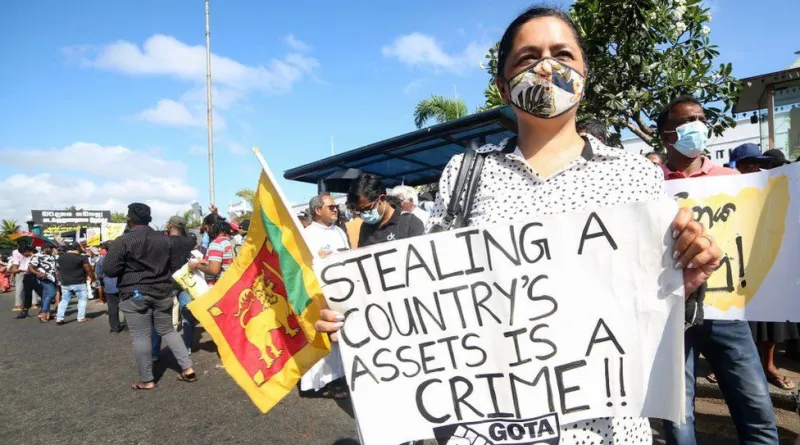The storming of the presidential palace and ignominious flight of President Gotabay Rajapaksa from Sri Lanka was so dramatic that numerous theories were spun to explain away a routine economic bankruptcy.
This arose from years of high fiscal deficits (government overspending) translating into high current account deficits (national overspending), empty foreign exchange reserves, and hence soaring inflation and debt default. This holds lessons for India. Some idealists claim that the underlying problem was ethnic tension and Sinhala crushing of minority Tamils and Muslims. Actually, Sri Lanka is an unfortunate but telling example of how a country can grow at a decent 5% rate for decades even with a terrible ethnic civil war. After crushing the Tamil Tigers and killing over 50,000 civilians in the process, the Rajapaksa government made no attempt to heal wounds with Tamils, yet Sri Lanka averaged 8. 5% GDP growth in the three years from 2010 to 2012.
Many Sri Lankans think the Rajapaksa family caused the crisis by looting the country before fleeing. There is no evidence of massive loot. Besides, a middle-income country cannot be busted by the diversion of a few billion dollars by politicians.
Some Indians believe the problem was a Chinese “debt trap”, with China lending so much that the country was unable to repay. China accounts for 15% of Sri Lanka’s debt, which is substantial but by no means dominant. China financed a billion-dollar white elephant port-cum-airport at Hambantota, Rajapaksa’s constituency, but then accepted a lease of the property in place of repayment, so this did not cause the debt default. China has lent somewhat recklessly with few conditionalities to many developing countries and is suffering as these borrowers default (Zambia is an earlier example). Currying favour with the Rajapaksas, which China is accused of, is surely the worst possible way to win friends and influence in Sri Lanka today.
Sri Lanka’s default has several economic lessons for India. Please focus on those and not bogus political theories.
Sri Lanka has always had a very low ratio of tax revenue to GDP, barely 10% in good years, yet combined this with populist giveaways and subsidies. This makes it vulnerable to setbacks, and it has often required bailing out by the International Monetary Fund. In 2016, it negotiated an IMF loan that aimed to almost halve the fiscal deficit from 6.9% of GDP to 3.5% by 2020. This was tough for a populist country.
It did make a start. But then came political instability and a constitutional crisis in 2018, followed by presidential and parliamentary elections in 2019 and 2020. Elections fuelled political competition to slash taxes. This populism took one million taxpayers out of the tax net. VAT was almost halved from 15% to 8% and sundry other taxes slashed. The fiscal deficit soared to 11% of GDP in 2020 and 12% in 2021. Bankruptcy was inevitable.
What India must learn
The lesson for India is clear. With a global recession and emerging markets crisis very likely, India must tighten fiscally now itself. The budget plan of a gradual reduction of 0.5% per year is much too gradual and must be speeded up.
Second, India is approaching a general election in 2024. It must resist the temptation to promise freebies and subsidies galore.
Third, Sri Lanka (like India) has become a middle-income country and so lost access to highly concessional loans from the World Bank. It shifted substantially to commercial loans at higher rates of interest, and this proved fatal. India too has lost access to concessional financing and must be careful about commercial debt.
Fourth, Sri Lanka is a classic case of a combined high fiscal and current account deficit causing soaring inflation and bankruptcy. India already has a high combined fiscal deficit of 11% for the centre and states. The current account deficit looks like doubling this year to 3% of GDP. Consumer inflation is 7% and wholesale price inflation at 15%. A crisis is not yet here but is certainly brewing, so get into combat mode right now.
Fifth, Sri Lanka tried forcing organic farming on farmers and banned fertiliser imports. Rice and tea harvests crashed 20% The BJP loves organic farming but must not force the pace of adoption.
Rising fiscal deficits took Sri Lanka’s debt/GDP ratio from 76% in 2016 to 117% today. India’s ratio widened to almost 90% because of Covid. The government needs to get it down fast.
India is better placed than most to face an emerging markets crisis. That does not mean it is safe. The political mood so far has been to stimulate a spurt in economic growth with the end of Covid. That mood needs total reversal. The worst is not over, it is yet to come. Let us prepare for that.
This article was originally published in The Times of India on July 17, 2022.


